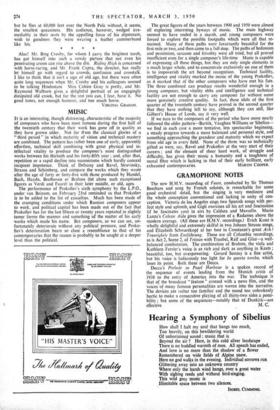GRAMOPHONE NOTES
The new H.M.V. recording of Faust, conducted by Sir Thomas Beecham and sung by French soloists, is remarkable for some good orchestral detail, but the singing is very mediocre and the whole conception conventional and lacking in unity of con- ception. Victoria de los Angeles sings two Spanish songs with per- fect style and aplomb, and Gigli exercises all his art and fascination (if he fascinates you) in airs by Caldara and Marcello. Mario Lanza's Celeste Aida gives the impression of a Radames above the modern average. (All these are H.M.V. recordings.) Erich Kunz is wholly delightful and extremely skilful in two Johann Strauss songs, and Elizabeth Schwarzkopf at her best in Constanze's -great Ach I Traurigkeit from Entfiihrung These are all Columbia recordings, as is Act 2, Scene 2, of Tristan with Traubel, Ralf and Glaz—a well- balanced combination. The combination of Brahms, the viola and Kathleen Ferrier's voice is as rich and dark as anything in Keats ; beautiful, too, but overpowering. Gerard Souzay is a fine artist, but his voice is ludicrously too light for In questa tomba, which loses its point. Both these are Decca. Decca's Prelude to Pearl Harbour is a spoken record of the sequence of events leading from the Munich crisis of 1938 to the entry of America into the war. The technique is that of the broadcast " feature " crossed with a news film, and the voices.of many famous personalities are woven into the narrative. The devices are rather too familiar and the mood too unbrokenly hectic to make a consecutive playing of all thirty-two sides a possi- bility; but some of the sequences—notably that of Dunkirk—are


































 Previous page
Previous page